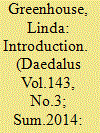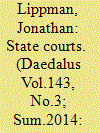|
|
|
Sort Order |
|
|
|
Items / Page
|
|
|
|
|
|
|
| Srl | Item |
| 1 |
ID:
132743


|
|
|
|
|
| Publication |
2014.
|
| Summary/Abstract |
This volume is both prequel and sequel. In 2008, Dædalus published an issue entitled "On Judicial Independence," exploring from a variety of perspectives the de½nition of that term, as well as ageold
and newly emergent threats to the ability of judges to do their work without undue constraint. Six years later, we both carry that story forward and shift the analytical frame to consider courts them selves: their past and ongoing evolution, and the work that a democracy can reasonably expect them to do. To write about courts is to write about political theory, about lawyering, about ½scal priorities, and about social welfare, as well as about courts' dependence on and independence from the body politic. The subject evokes a great variety of conversations, from the highly theoretical to the nitty gritty of service delivery for human needs in all their man - ifestations. Discussions of courts, at least in the United States, bring lawyers rapidly into view, along with criminal defendants, civil litigants, administrative agencies, budgets, public ½nancing, and popular opinion.
|
|
|
|
|
|
|
|
|
|
|
|
|
|
|
|
| 2 |
ID:
132749


|
|
|
|
|
| Publication |
2014.
|
| Summary/Abstract |
In New York, millions of civil litigants each year fight for the necessities of life without the aid of a lawyer because they are unable to afford one. While the state courts strive to provide access to justice for all constituents, this ideal becomes a promise unfulfilled due to the lack of available civil legal services for low-income populations. In this essay, I discuss access to justice in the state courts from the perspective of my role as Chief Judge of the State of New York. I examine the enormity of the unmet need in New York and around the country and discuss the measures I have taken as head of the New York State court system to address the crisis. These efforts have resulted in a substantial increase in state funding for civil legal services, the establishment of the Task Force to Expand Access to Civil Legal Services in New York, annual hearings in each of New York's four Judicial Departments, and the development of programs designed to spur the legal community (including law students) to greater involvement in pro bono work.
|
|
|
|
|
|
|
|
|
|
|
|
|
|
|
|
|
|
|
|
|